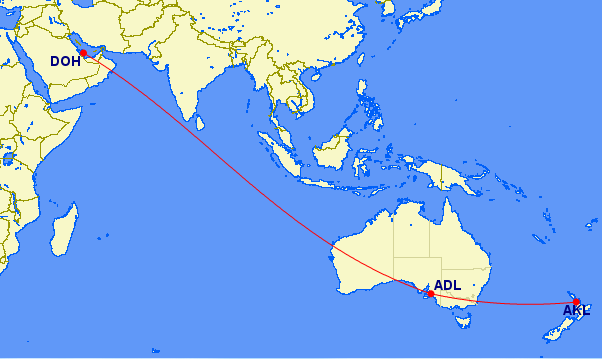Qatar Airways: World's longest 'direct' flight is making stopovers in Australia due to fuel shortage
Some aircraft are having to make unscheduled stops soon after take-off in order to fill up

The world’s longest non-stop flight has been reduced to a protracted one-stop trip due to Auckland airport running short of jet fuel.
Qatar Airways flight 921 is scheduled to cover the 9,025 miles from New Zealand’s largest city to Doha in 18 hours. But because of what Auckland airport calls a “temporary fuel supply disruption”, for the last week it has stopped in Australia to fill its tanks — typically adding three hours to the journey time.
The pipeline between New Zealand’s only oil refinery, at Marsden Point, and the depot which supplies airlines operating at Auckland airport, has been damaged. As a result, only about one-third of the normal usage is being delivered and oil companies are rationing the amount of fuel they supply.
While the pipeline was repaired at the weekend, continuing shortages are affecting flying.
Pilots of short-haul flights, such as domestic services or hops across the Tasman Sea to eastern Australia, can “tanker” fuel, arriving in Auckland with enough on board to operate the return leg. But many long-haul flights are having to make unscheduled stops soon after take-off from the city in order to fill up.
Over the past week, the daily Qatar Airways Boeing 777 to Doha has mainly landed at Adelaide, with some services touching down in Melbourne instead. Both Australian airports are off the most direct track between Auckland and Doha, meaning that the journey is extended.
The world’s second-longest flight also begins in Auckland: Emirates’ non-stop trip to Dubai, 8,817 miles away. The Airbus A380 used for the service has refuelled at either Melbourne or Brisbane.
The time spent descending, on the ground and ascending again typically adds two or three hours to the journey. It also increases costs by tens of thousands of pounds, with extra fuel burn, landing charges and wear and tear on the airframe and engines.
In addition, passengers who miss their connections because of the longer journeys need to be provided with hotels and alternative flights.
The fuel shortage also presents fleet allocation issues, with round-trips typically taking several hours longer than expected. There are crewing problems too, with ultra-long-haul flights on Qatar Airways and Emirates becoming even longer one-stop flights that require additional crew to avoid infringing flight-time limitations.
Air New Zealand is the airline most affected by the fuel crisis. It has managed to keep its flagship Auckland-London service on schedule, with the Boeing 777 fuelled for the 6,500-plus miles to the en route stop at Los Angeles.
Other services, such as a recent Auckland-Houston round-trip, have been cancelled, with the daily trip to Hong Kong picking up fuel in Brisbane.
In the past few days Air New Zealand has avoided cancellations. The airline says it is “continuing to implement a range of measures to reduce fuel uplift in Auckland including some long-haul international services making refuelling stops at either Australian or Pacific Island airports.”
Air New Zealand says it believes “the situation is stabilising and will continue to be manageable in the absence [of] any further complications”.
Qantas took extreme action by flying a Boeing 747 filled with fuel from Sydney to Auckland in order to replenish the tanks of Australia-bound planes.
Join our commenting forum
Join thought-provoking conversations, follow other Independent readers and see their replies
Comments